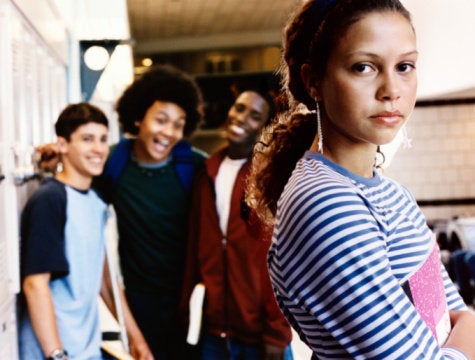
"We are all either bullies, bullied, or bystanders," says Dr. Richard Gross, American Psychiatric Association's School Health Committee member. I can certainly remember feeling that way as a kid trying to navigate the perilous land of 'Playground.' I'll admit to trying on each of those roles in the brave grade school quest to secure a place in the Kingdom. After enduring some pretty mean stuff, then turning around and doling out some pretty mean stuff (I sincerely apologize to anyone I was horrible to middle school), I guess I fell into my groove as a bystander. By high school, though I didn't recognize it then, I was feeling pretty lowly in the world (that looked like lots of risky behavior and periodically starving myself). I joined the Drama Club, probably for the attention, and liked it. As you might guess, I never did achieve cool (still haven't), but I did find a place free of social pressure and labels where I learned to stand in the line of teenage fire unscathed. Now, as an adult, I have little difficulty deflecting the bullets directed toward me, and standing up for others when necessary. I think Dr. Gross overlooked a tier in the bully world order -- Bullet proof.
As we saw in Davis Guggenheim's Waiting for Superman, innovators are the new superheroes. Now, more than ever, success depends on the ability to let cynicism bounce off you, think outside the box, embrace new perspectives, be a champion for the unfamiliar and unpopular, and effectively communicate a creative vision. We've been hearing a lot lately about how arts education contributes to the development of these 21st century skills, but let's also be sure to note that arts education doesn't only better prepare our children to become scientists and world leaders, it can keep them safe.
While we're on the subject of 21st century skills, 21st century bullying is not the Leave it to Beaver version of lunch money extortion and name-calling (not that those things don't suck... I, formerly Kristi Greer, spent a good part of first grade as 'Crusty Queer.' That left a mark). According to the National Education Association (NEA), bullying has become more frequent, and lethal, than ever in the last decade. Overt bullying that can be seen and stopped by an adult is falling by the wayside in the digital age. We've all heard of cyberbullying, for example, and today's kids are more sophisticated in general about the whys and hows of vying for social status. Even elementary school kids are acutely aware of the power that comes with being in control of who's "in" and who's "out." Bullying isn't limited to boys, either. Emotional bullying in form of coercion and exclusion is associated more with girls, in fact. They're called "mean girls," and judging from the grown-up pettiness that goes on around birthday party invitations, PTAs, and mommy groups, they aren't just picking it up from TV.
Bullying has become an insidious part of our culture, easier to ignore, and easier to rationalize. As President Obama stressed at the White House bullying prevention conference held earlier this year in response to a rash of bullying-related suicides, we must "dispel the myth that bullying is just a harmless rite of passage or an inevitable part of growing up." The damage to our children -- the bullies, the bullied, and the bystanders all -- is catastrophic. Further research presented on the federally sponsored anti-bullying website, StopBullying.gov, confirms that bullies are more likely to use drugs, to be truant, to commit violent crimes, and to be diagnosed with antisocial personality disorder as an adult. What's more? The bullied are more likely to use drugs, to be truant, to commit violent acts of retaliation, and to experience anxiety and depression. Bystanders, the ones who watch it happen, but don't do anything about it for fear of retaliation or losing their place in the caste, don't get off much easier. They are also more likely to use drugs, to be truant, and experience anxiety and depression.
Arts education, particularly theater education, may be an effective method of teaching young people tolerance, and helping them recognize, and stand up against, injustice. In short, to become bullet-proof. Many Los Angeles County public schools are adopting anti-bullying curricula that include dramatic role-playing geared toward shifting the perspective of the bullies, empowering the bullied, and providing the bystanders with the tools they need to intervene. One of the Theater Teaching Artists I work with at P.S. ARTS is in charge of teaching the anti-bullying curriculum at her Santa Monica public elementary school. She shared that the kids really need a supported environment to explore the complex dynamics of bullying, and described a play written by a student that encouraged kids to notice the physiological signs of anger, like feeling hot, and practice ways they can calm themselves down. Another P.S. ARTS Theater teacher, tormented in grade school by a bully, focuses on the power of strengthening communities by teaching kids to boost each other up. She posts a quote by Indira Gandhi on the wall, "You can't shake hands with a clenched fist," and ends every class by having each student give another a compliment.
One final thought... On top of the physical and emotional toll of bullying, teen violence costs Americans about $158 billion a year. With a projected National Endowment for the Arts budget of just $167.5 million next year, investing more to decrease the incidence of bullying through arts education seems to yield a pretty high return. How much do you think it's worth to make our children bullet proof?